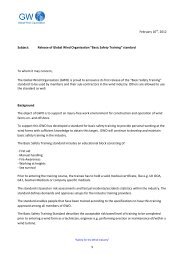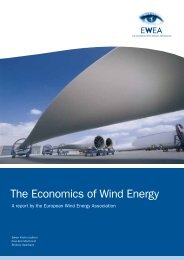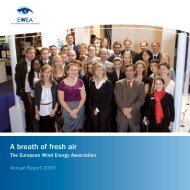Offshore Electricity Infrastructure in Europe - European Wind Energy ...
Offshore Electricity Infrastructure in Europe - European Wind Energy ...
Offshore Electricity Infrastructure in Europe - European Wind Energy ...
You also want an ePaper? Increase the reach of your titles
YUMPU automatically turns print PDFs into web optimized ePapers that Google loves.
esults<br />
(figure to the right) <strong>in</strong> Northern <strong>Europe</strong>, as assumed <strong>in</strong><br />
the 2030 scenario of <strong>Offshore</strong>Grid: areas of low correlation<br />
are illustrated <strong>in</strong> blue, high correlation <strong>in</strong> red.<br />
The figures show that most of the offshore capacities<br />
<strong>in</strong> the 2030 scenario are concentrated <strong>in</strong> the southern<br />
part of the North Sea. In contrast to this, the onshore<br />
w<strong>in</strong>d power <strong>in</strong> the scenario is more or less evenly distributed<br />
over Northern <strong>Europe</strong>. In total, w<strong>in</strong>d energy is<br />
clearly concentrated <strong>in</strong> the North. This concentration<br />
will pose considerable challenges for power flows <strong>in</strong><br />
the future <strong>Europe</strong>an electricity grid.<br />
The correlation of the offshore w<strong>in</strong>d power shows<br />
a clear west-east pattern: the figure on the left <strong>in</strong><br />
Figure 4.2 reflects that the w<strong>in</strong>d power production is<br />
more correlated from west to east than between north<br />
and south. Moreover the ma<strong>in</strong> w<strong>in</strong>d direction is from<br />
west to east, especially the low pressure weather systems<br />
with strong w<strong>in</strong>d speeds also move ma<strong>in</strong>ly from<br />
west to east.<br />
The analysis shows that grid <strong>in</strong>terconnections between<br />
regions of low weather correlation can significantly<br />
reduce the variability of <strong>Europe</strong>an w<strong>in</strong>d power production.<br />
Interconnectors runn<strong>in</strong>g <strong>in</strong> a north to south<br />
direction br<strong>in</strong>g the highest benefit for the reduction of<br />
w<strong>in</strong>d power variability.<br />
Spatial correlations of w<strong>in</strong>d power<br />
production between countries<br />
With the simulated w<strong>in</strong>d power time series, the spatial<br />
correlations between <strong>in</strong>dividual countries were also <strong>in</strong>vestigated.<br />
The results are shown <strong>in</strong> Table 4.1, which<br />
confirms the f<strong>in</strong>d<strong>in</strong>gs above. The correlations are<br />
highest <strong>in</strong> the east-west direction, for example a correlation<br />
of 74% between the UK and the Netherlands,<br />
67% between the UK and Germany, and still 29% between<br />
the UK and Poland. This is much less <strong>in</strong> the<br />
north-south direction, with correlations of only 44%<br />
between Norway and Denmark, 16% between F<strong>in</strong>land<br />
and Poland, and even only 5% between Norway and<br />
France. The comb<strong>in</strong>ation Germany-UK yields higher average<br />
variations than a comb<strong>in</strong>ation Norway-Belgium.<br />
This means that from a w<strong>in</strong>d power variability po<strong>in</strong>t of<br />
view, a north-south <strong>in</strong>terconnection between Norway<br />
and Belgium would be more beneficial than an eastwest<br />
<strong>in</strong>terconnection between the UK and Germany.<br />
The figures <strong>in</strong> Table 4.1 can be used <strong>in</strong> the prelim<strong>in</strong>ary<br />
assessment of new <strong>in</strong>terconnectors that are meant for<br />
trad<strong>in</strong>g w<strong>in</strong>d power. Low correlation would h<strong>in</strong>t at the<br />
need for new <strong>in</strong>terconnect<strong>in</strong>g capacity <strong>in</strong> order to fully<br />
utilise the variable w<strong>in</strong>d resource.<br />
TAblE 4.1: cORRElATION cOEFFIcIENTS bETWEEN cOUNTRIES USING SIMUlATEd WINd POWER TIME SERIES FOR ThE<br />
OFFShOREGRId 2030 WINd POWER ScENARIO (ON- & OFFShORE WINd TOGEThER) (%)<br />
BE DK eT Fi Fr De uK IR lA lT Nl NO Pl Ru se<br />
BE 100% 45% 12% 2% 59% 67% 66% 37% 20% 21% 79% 12% 28% 20% 22%<br />
DK 45% 100% 32% 17% 32% 76% 49% 20% 44% 48% 77% 44% 78% 48% 73%<br />
eT 12% 32% 100% 51% 10% 18% 16% 12% 66% 66% 22% 13% 36% 45% 69%<br />
Fi 2% 17% 51% 100% 2% 6% 7% 4% 30% 34% 10% 23% 16% 19% 49%<br />
Fr 59% 32% 10% 2% 100% 37% 49% 43% 16% 18% 46% 5% 23% 17% 20%<br />
De 67% 76% 18% 6% 37% 100% 67% 26% 28% 30% 87% 40% 53% 32% 43%<br />
uK 66% 49% 16% 7% 49% 67% 100% 62% 20% 21% 74% 37% 29% 21% 27%<br />
IR 37% 20% 12% 4% 43% 26% 62% 100% 13% 14% 33% 14% 15% 13% 13%<br />
lA 20% 44% 66% 30% 16% 28% 20% 13% 100% 89% 32% 15% 55% 74% 69%<br />
lT 21% 48% 66% 34% 18% 30% 21% 14% 89% 100% 34% 17% 61% 88% 72%<br />
Nl 79% 77% 22% 10% 46% 87% 74% 33% 32% 34% 100% 36% 50% 34% 49%<br />
NO 12% 44% 13% 23% 5% 40% 37% 14% 15% 17% 36% 100% 24% 16% 30%<br />
Pl 28% 78% 36% 16% 23% 53% 29% 15% 55% 61% 50% 24% 100% 65% 73%<br />
Ru 20% 48% 45% 19% 17% 32% 21% 13% 74% 88% 34% 16% 65% 100% 59%<br />
se 22% 73% 69% 49% 20% 43% 27% 13% 69% 72% 49% 30% 73% 59% 100%<br />
34 <strong>Offshore</strong>Grid – F<strong>in</strong>al Report<br />
–1<br />
–0.9<br />
–0.8<br />
–0.7<br />
–0.6<br />
–0.5<br />
–0.4<br />
–0.3<br />
–0.2<br />
–0.1<br />
–0









